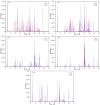Detection of Counterfeit Perfumes by Using GC-MS Technique and Electronic Nose System Combined with Chemometric Tools
- PMID: 36984931
- PMCID: PMC10052770
- DOI: 10.3390/mi14030524
Detection of Counterfeit Perfumes by Using GC-MS Technique and Electronic Nose System Combined with Chemometric Tools
Abstract
The Scientific Committee on Cosmetic and Non-Food Products has identified 26 compounds that may cause contact allergy in consumers when present in concentrations above certain legal thresholds in a product. Twenty-four of these compounds are volatiles and can be analyzed by gas chromatography-mass spectrometry (GC-MS) or electronic nose (e-nose) technologies. This manuscript first describes the use of the GC-MS approach to identify the main volatile compounds present in the original perfumes and their counterfeit samples. The second part of this work focusses on the ability of an e-nose system to discriminate between the original fragrances and their counterfeits. The analyses were carried out using the headspace of the aqueous solutions. GC-MS analysis revealed the identification of 10 allergens in the perfume samples, some of which were only found in the imitated fragrances. The e-nose system achieved a fair discrimination between most of the fragrances analyzed, with the counterfeit fragrances being clearly separated from the original perfumes. It is shown that associating the e-nose system to the appropriate classifier successfully solved the classification task. With Principal Component Analysis (PCA), the three first principal components represented 98.09% of the information in the database.
Keywords: GC-MS; allergens; counterfeit; electronic nose; perfumes; volatile organic compounds.
Conflict of interest statement
The authors declare no conflict of interest.
Figures






Similar articles
-
Ionic liquids as water-compatible GC stationary phases for the analysis of fragrances and essential oils: Quantitative GC-MS analysis of officially-regulated allergens in perfumes.J Chromatogr A. 2020 Jan 11;1610:460567. doi: 10.1016/j.chroma.2019.460567. Epub 2019 Oct 5. J Chromatogr A. 2020. PMID: 31629492
-
Wastewater monitoring by means of e-nose, VE-tongue, TD-GC-MS, and SPME-GC-MS.Talanta. 2021 Jan 1;221:121450. doi: 10.1016/j.talanta.2020.121450. Epub 2020 Jul 31. Talanta. 2021. PMID: 33076073
-
Discrimination of Two Cultivars of Alpinia Officinarum Hance Using an Electronic Nose and Gas Chromatography-Mass Spectrometry Coupled with Chemometrics.Sensors (Basel). 2019 Jan 30;19(3):572. doi: 10.3390/s19030572. Sensors (Basel). 2019. PMID: 30704021 Free PMC article.
-
Application of gas chromatography-ion mobility spectrometry (GC-IMS) and ultrafast gas chromatography electronic-nose (uf-GC E-nose) to distinguish four Chinese freshwater fishes at both raw and cooked status.J Food Biochem. 2022 Jun;46(6):e13840. doi: 10.1111/jfbc.13840. Epub 2021 Jun 30. J Food Biochem. 2022. PMID: 34189733
-
[Recent advances in the application of headspace gas chromatography-mass spectrometry].Se Pu. 2018 Oct 8;36(10):962-971. doi: 10.3724/SP.J.1123.2018.05013. Se Pu. 2018. PMID: 30378354 Review. Chinese.
Cited by
-
Design of an Electronic Nose System with Automatic End-Tidal Breath Gas Collection for Enhanced Breath Detection Performance.Micromachines (Basel). 2025 Apr 14;16(4):463. doi: 10.3390/mi16040463. Micromachines (Basel). 2025. PMID: 40283338 Free PMC article.
References
-
- Guć M., Cegłowski M., Pawlaczyk M., Kurczewska J., Reszke E., Schroeder G. Application of FAPA mass spectrometry for analysis of fragrance ingredients used in cosmetics. Measurement. 2021;168:108326. doi: 10.1016/j.measurement.2020.108326. - DOI
-
- Mishra J., Sahgal N. Navigating the Noteworthy: Regulating the Vulnerability of the Fragrance Industry. Indian J. Intell. Prop. L. 2017;8:27.
-
- Chaudhry P., Zimmerman A. Protecting Your Intellectual Property Rights. Springer; New York, NY, USA: 2013. The global growth of counterfeit trade; pp. 7–31. - DOI
-
- Feng Y., Cheng X., Lu Y., Wang H., Chen D., Luo C., Liu H., Gao S., Lei T., Huang H., et al. Gas chromatography-mass spectrometry analysis of floral fragrance-related compounds in scented rose (Rosa hybrida) varieties and a subsequent evaluation on the basis of the analytical hierarchy process. Plant Physiol. Biochem. 2022;185:368–377. doi: 10.1016/j.plaphy.2022.06.007. - DOI - PubMed
Grants and funding
LinkOut - more resources
Full Text Sources
Miscellaneous

